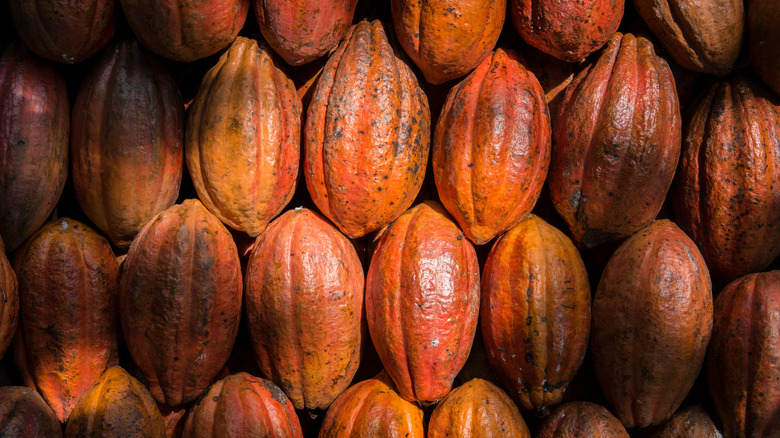How Climate Change Could Decimate The World's Chocolate Supply
Few foods, if any, have been glorified in global culture more than chocolate. It's managed to associate itself with nearly every single holiday from chocolate bars at Halloween to heart-shaped boxes on Valentine's Day, to those adorable chocolate Easter bunnies that children torture by chomping off one ear at a time.
As if holiday domination wasn't enough, chocolate constantly works its way into the news. It seems like each year brings a new study revealing more exciting health benefits to be gained from eating chocolate. For example, according to a 2015 study in the Journal of the International Society of Sports Nutrition, chocolate may "boost oxygen availability" while exercising (via Medical News Today). Though, according to Vox, major brands like Nestle, Mars, and Hershey's spend millions of dollars to back these types of studies.
The chocolate industry is worth over $100 billion, per Insider, which also reports that the industry intentionally outproduces demand to keep prices cheap. That's good news for customers right now, but the industry might need to make some serious cutbacks in the next decade if it wants to survive the effects of climate change. The global climate crisis is expected to devastate the food supply, threatening such beloved staples as corn, potatoes, and yes, even chocolate.
Cacao can only grow in a certain climate
Chocolate is made from the seeds of the cacao tree, which is native to the Amazon rainforest, per JSTOR. Today, it is one of the most important crops in the tropics, partially because it can't grow anywhere else. According to the National Oceanic and Atmospheric Administration (NOAA), cacao can only grow within 20 latitudinal degrees of the equator. Lands within this range include Côte d'Ivoire and Ghana, which together produce over 50% of the world's chocolate. These tropical latitudes are characterized by consistently warm weather, high humidity, and nutrient-rich soil. However, they are now experiencing dramatic increases in temperature that could threaten cacao farming.
NOAA notes that high temperatures aren't the real concern here, but rather a loss of moisture. As the weather heats up, more water will evaporate from soil and plants, drying out the climate, and that's when cacao trees will really start to suffer. According to a 2011 study by the International Center for Tropical Agriculture, farmers could experience a significant decline in cacao production as early as 2030.
There is some cause for hope, though, as JSTOR cites a 2021 study by Peruvian ecologists showing that wild cacao trees could fare well in the future even if cacao farms fail. However, domesticating those wild crops and preventing them from facing the same fate as current farms won't be easy. While nobody wants to admit it, our love of chocolate might start to go unrequited sooner than we thought.

